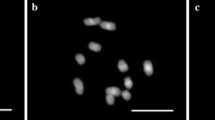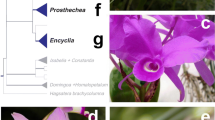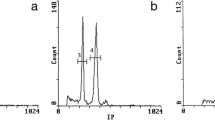Abstract
Having more than 25,000 species belonging to >800 genera, orchids are renowned for the abundance of morphotypes, with apparently everlasting compilation of extraordinary and fantastic adaptations, and represent a highly advanced terminal line of floral evolution in the angiosperms. The pattern of speciation and evolution in the family Orchidaceae is still elusive due to lack of information on valuable chromosome landmarks including centromeres, telomeres, nucleolar organizing regions (NORs), accessory chromosomes, structural rearrangements, eu/hetero-chromatin structure that ultimately resulted in complex genome organization. Therefore, an attempt has been made to catalog the available information on chromosome research in orchids encompassing the wide spectrum of conventional/molecular cytogenetics. Further, the recent developments in the broad scope of epi-cytogenetics involving nuclear architecture, spatial-temporal chromosomal distribution of DNA/histone modification marks, and their interplay in the formation of chromatin environment during cell division have been discussed. The application of flow-cytogenetics in unrevealing the complex genome architecture and ploidy of orchids has also been considered significantly. Further, in view of recent availability of the transcriptome and genome sequences of orchids, the potential of next-generation cytogenetics in discovery of myriad cytogenetic milestones for uncovering the mysteries of orchid’s genome and concurrent evolution has also been addressed. In particular, this review ultimately provides a broad scope and perspectives in different aspects of chromosome research on the highly evolved yet complex orchid family.






Similar content being viewed by others
References
Aoyama M. Karyomorphological studies in Cymbidium and its allied genera, Orchidaceae. Bull Hiroshima Bot Gard. 1989;11:1–121.
Arditti J. Fundamentals of orchid biology. New York: Wiley; 1992.
Begum R, Alam SS, Menzel G, Schmid T. Comparative molecular cytogenetics of major repetitive sequence families of three Dendrobium species (Orchidaceae) from Bangladesh. Ann Bot. 2009;104:863–72.
Bolaños-Villegas P, Chin SW, Chen FC. Meiotic chromosome behavior and capsule setting in Doritaenopsis hybrids. J Am Soc Hort Sci. 2008;133:107–16.
Brown RC. Lemmon BE Pollen development in orchids.3. A novel generative pole microtubule system predicts unequal pollen mitosis. J Cell Sci. 1991;99:273–81.
Brown RC. Lemmon BE Pollen development in orchids.4. Cytoskeleton and ultrastructure of the unequal pollen mitosis in Phalaenopsis. Protoplasma. 1992;167:183–92.
Brown RC, Lemmon BE. Pollen mitosis in the slipper orchid Cypripedium fasciculatum. Sex Plant Reprod. 1994;7:87–94.
Cabral JS, Felix LP, Guerra M. Heterochromatin diversity and its co-localization with 5S and 45S rDNA sites in chromosomes of four Maxillaria species (Orchidaceae). Genet Mol Biol. 2006;29:659–64.
Cai J, Liu X, Vanneste K, Proost S, Tsai WC, Liu KW, et al. The genome sequence of the orchid Phalaenopsis equestris. Nat Genet. 2015;47:65–72.
Cox AV, Abdelnour DG, Bennett MD, Leitch IJ. Genome size and karyotype evolution in the slipper orchids (Cypripedioideae: Orchidaceae). Am J Bot. 1998;85:681–87.
D’emerico S, Galasso I, Pignone D, Scrugli A. Localization of rDNA loci by fluorescent in situ hybridization in some wild orchids from Italy (Orchidaceae). Caryologia. 2001;54:31–6.
Daviña JR, Grabiele M, Cerutti JC, Hojsgaard DH, Almada RD, Insaurralde IS, et al. Chromosome studies in Orchidaceae from Argentina. Genet Mol Biol. 2009;32:811–21.
Dressler RL. Phylogeny and classification of the orchid family. Portland: Dioscorides; 1993.
Ehrendorfer F. Polyploidy and distribution. In: Lewis WH, editor. Polyploidy: Biological relevance. New York: Plenum Press; 1980. p. 45–60.
Felix LP, Guerra M. Basic chromosome numbers of terrestrial orchids. Plant Syst Evol. 2005;254:131–48.
Felix LP. GuerraM. Cytogenetics and cytotaxonomy of some Brazilian species of Cymbidioid orchids. Genet Mol Biol. 2000;23:957–78.
Fu CH, Chen YW, Hsiao YY, Pan ZJ, Liu ZJ, Huang YM, et al. OrchidBase: a collection of sequences of the transcriptome derived from orchids. Plant Cell Physiol. 2011;52:238–43.
Goldblatt P. Polyploidy in angiosperms: monocotyledons. In: Lewis WH, editor. Polyploidy: biological relevance. New York: Plenum Press; 1980. p. 219–32.
Griesbach RJ. Polyploidy in Phalaenopsis orchid improvement. J Hered. 1985;76:74–5.
Heslop-Harrison JS. Comparative genome organization in plants: from sequence and markers to chromatin and chromosomes. Plant Cell. 2000;12:617–36.
Hsiao YY, Pan ZJ, Hsu CC, Yang YP, Hsu YC, Chuang YC, et al. Research on orchid biology and biotechnology. Plant Cell Physiol. 2011;52:1467–86.
Hsu SC, Cheng TC, Bolaños-Villegas P, Chin SW, Chen FC. Pollen Meiotic Behavior in Relation to Phalaenopsis Breeding. In: Blanchard MG. editor. Proc Ist Intl Orchid Symposium Acta Hort. 2010. p. 878.
Hsu CC, Chung YC, Chen TC, Lee YL, Kuo YT, Tsai WC, et al. An overview of the Phalaenopsis orchid genome through BAC end sequence analysis. BMC Plant Biol. 2011;11:3.
Jones K. Cytology and the study of orchids. In: Withner CL, editor. The orchids: scientific studies. New York: Wiley; 1974. p. 383–89.
Jones RN, Vij SP. B chromosomes in orchids. J Orchid Soc India. 1988;2:77–85.
Jones WE, Kuehnle AR. Ploidy identification using flow cytometry in tissues of Dendrobium species and cultivars. Lindleyana. 1998;13:11–8.
Kao YY, Chang SB, Lin TY, Hsiehs CH, Chen YH, ChenWHand Chen CC. Differential accumulation of heterochromatin as a cause for karyotype variation in Phalaenopsis orchids. Ann Bot. 2001;87:387–95.
Lan T, Albert VA. Dynamic distribution patterns of ribosomal DNA and chromosomal evolution in Paphiopedilum, a lady’s slipper orchid. BMC Plant Biol. 2011;11:126.
Lee HC, Chiou DW, Chen WH. Dynamics of cell growth and endoreduplication during orchid flower development. Plant Sci. 2004;166:659–67.
Lee YH. Cytology and fertility of an intergeneric orchid hybrid. J Hered. 1987;78:319–22.
Lee YI, Chung MC. Identification of genome relationships among Paphiopedilum species by genomic and fluorescent in situ hybridization. Acta Hortic. 2008;766:331–34.
Leitch IJ, Kahandawala I, Suda J, Hanson L, Ingrouille MJ, Chase MW, et al. Genome size diversity in orchids: consequences and evolution. Ann Bot. 2009;104:469–81.
Lim WL, Loh CS. Endopolyploidy in Vanda Miss Joaquim (Orchidaceae). New Phytol. 2003;159:279–87.
Lin CC, Chen YH, Chen WH, Chen CC, Kao YY. Genome organization and relationships of Phalaenopsis orchids inferred from genomic in situ hybridization. Bot Bull Acad Sin. 2005;46:339–45.
Lin S, Lee HC, Chen WH, Chen CC, Kao YY, Fu YM, et al. Nuclear DNA contents of Phalaenopsis sp. and Doritis pulcherrima. J Am Soc Hortic Sci. 2001;126:195–99.
Matsuba A, Fujii M, Lee SS, Suzuki G, Yamamoto M, Mukai Y. Molecular cytogenetic use of BAC clones of Neofinetia falcate and Rhynchostylis coelestis Nucleus. doi:10.1007/s13237-015-0147-y.
Moscone EA, Samuel R, Schwarzacher T, Schweizer D, Pedrosa-Harand A. Complex rearrangements are involved in Cephalanthera (Orchidaceae) chromosome evolution. Chromosome Res. 2007;15:931–43.
Nagl W. Heterochromatin elimination in the orchid Dendrobium. Protoplasma. 1983;118:234–37.
Nagl W. Localization of amplified DNA in nuclei of the orchid Cymbidium by in situ hybridization. Experientia. 1977;33:1040–41.
Okada H. Karyomorphological observations of Apostasia nuda and Neuwiedia veratrifolia (Apostasiaceae, Orchidaceae). J Jpn Bot. 1988;63:344–50.
Pan ZJ, Cheng CC, Tsai WC, Chung MC, Chen WH, Hu JM, et al. The duplicated B-class MADS-Box genes display dualistic characters in orchid floral organ identity and growth. Plant Cell Physiol. 2011;52:1515–31.
Raven PH. The bases of angiosperm phylogeny: cytology. Ann Mo Bot Gard. 1975;62:724–64.
Roy SC, Sharma AK. Cytological studies of Indian orchids. Proc Ind Natl Sci Acad. 1972;38:72–86.
Sharma AK, Chetterji AK. The chromosome numbers of few more orchid genera. Curr Sci. 1966;30:75.
Sharma SK, Rajkumari K, Kumaria S, Tandon P, Rao SR. Karyo-morphological characterization of natural genetic variation in some threatened Cymbidium species of Northeast India. Caryologia. 2010;63:99–105.
Sharma SK, Kumaria S, Tandon P, Rao SR. Comparative karyomorphological study of some Indian Cymbidium Swartz, 1799 (Cymbidieae, Orchidaceae). Comp Cytogenet. 2012;6:453–65.
Sharma SK, Kumaria S, Tandon P, Rao SR. Endomitosis in tapetal cells of some cymbidiums (Orchidaceae). Nucleus. 2012;55:21–5.
Sharma SK, Mehra P, Kumari J, Kumar S, Kumaria S, Tandon P, et al. Physical localization and probable transcriptional activity of 18S-5.8S-26S rRNA gene loci in some Asiatic cymbidiums (Orchidaceae) from north-east India. Gene. 2012;499:362–66.
Sharma SK, Dhar J, Kumaria S, Tandon P, Rao SR. Assessment of phylogenetic inter-relationships in the genus Cymbidium (Orchidaceae) based on internal transcribed spacer region of rDNA. Gene. 2012;495:10–5.
Sharma SK, Kumaria S, Tandon P, Rao SR. Single Primer Amplification Reaction (SPAR) methods reveal the intra-specific natural genetic variation in five species of Cymbidium (Orchidaceae). Gene. 2011;483:54–62.
Sharma SK, Kumaria S, Tandon P, Rao SR. Assessment of genetic variation and identification of species-specific ISSR markers in five species of Cymbidium (Orchidaceae). J Plant Biochem Biotechnol. 2013;22:250–55.
Sharma SK, Yamamoto M, Mukai Y. Immuno-cytogenetic manifestation of epigenetic chromatin modification marks in plants. Planta. 2015;241:291–301.
Shekhar N. Cytotaxonomic studies in some Indian Orchids (Ph.D thesis). Chandigarh: Punjab University; 1984.
Stace CA. Cytology and cytogenetics as a fundamental taxonomic resource for the twenty and twenty first centuries. Taxon. 2000;49:451–77.
Stebbins GL. Chromosomal evolution in higher plants. London: Edward Arnold; 1971.
Szlachetko D. Sistema orchidalium. Frag Flor Geob. 1995;3(Suppl):1–152.
Teoh SB, Ong EC. Differential meiotic behaviour in hybrid clones of Aranda. Euphytica. 1983;32:799–806.
Teoh SB. Polyploid spore formation in diploid orchid species. Genetica. 1984;63:53–9.
Than MMM, Pal A, Jha S. Chromosome number and modal karyotype in a polysomatic endangered orchid, Bulbophyllum auricomum Lindl., the Royal Flower of Myanmar. Plant Syst Evol. 2011;294:167–75.
Tsai WC, Fu CH, Hsiao YY, Huang YM, Chen LJ, Wang M, et al. OrchidBase 2.0: comprehensive collection of orchidaceae floral transcriptomes. Plant Cell Physiol. 2013;54:e7.
Vij SP, Mehra PN. Cytological studies in East Himalayan Orchidaceae III: Cypripedieae. Caryologia. 1974;27:293–300.
Vij SP, Mehra PN. Cytological studies in the East Himalayan Orchidaceae 4: Epidendreae. Res Bull (Sci) Panjab Univ. 1976;27:51–98.
Vij SP, Shekhar N. Cytogenetical aspects of Indian orchids. In: Vij SP, editor. Biology, conservation, and culture of orchids. New Delhi: Affiliated East-West Press Pvt. Ltd.; 1986. p. 189–220.
Yang M, Loh CS. Systematic endopolyploidy in Spathoglottis plicata (Orchidaceae) development. BMC Cell Biol. 2004;5:33–9.
Acknowledgments
We thank Japan Society for the Promotion of Science (JSPS), Japan for providing post-doctoral fellowship (SKS, no. P13399) and Grants-in-Aid for Scientific Research (C) (YM, no. 25450006) in the field of orchid cytogenetics. Sincere thanks are also due to Prof. Maki Yamamoto, Kansai University of Welfare Sciences, Osaka, and Prof. Go Suzuki and all members of Plant Molecular Genetics Laboratory, Osaka Kyoiku University, Osaka, Japan for their constant encouragement and help. We also thank Osaka Kyoiku University, Osaka, Japan for providing the facilities. Sincere apologies to those authors whose work(s) we could not cite due to space limitations.
Author information
Authors and Affiliations
Corresponding author
Ethics declarations
Conflict of interest
Authors declare no conflict of interest. SKS and YM designed the theme of the study. SKS did the experiments and wrote the manuscript. YM provided valuable inputs for significant improvement of the quality of the manuscript.
Rights and permissions
About this article
Cite this article
Sharma, S.K., Mukai, Y. Chromosome research in orchids: current status and future prospects with special emphasis from molecular and epigenetic perspective. Nucleus 58, 173–184 (2015). https://doi.org/10.1007/s13237-015-0152-1
Received:
Published:
Issue Date:
DOI: https://doi.org/10.1007/s13237-015-0152-1




